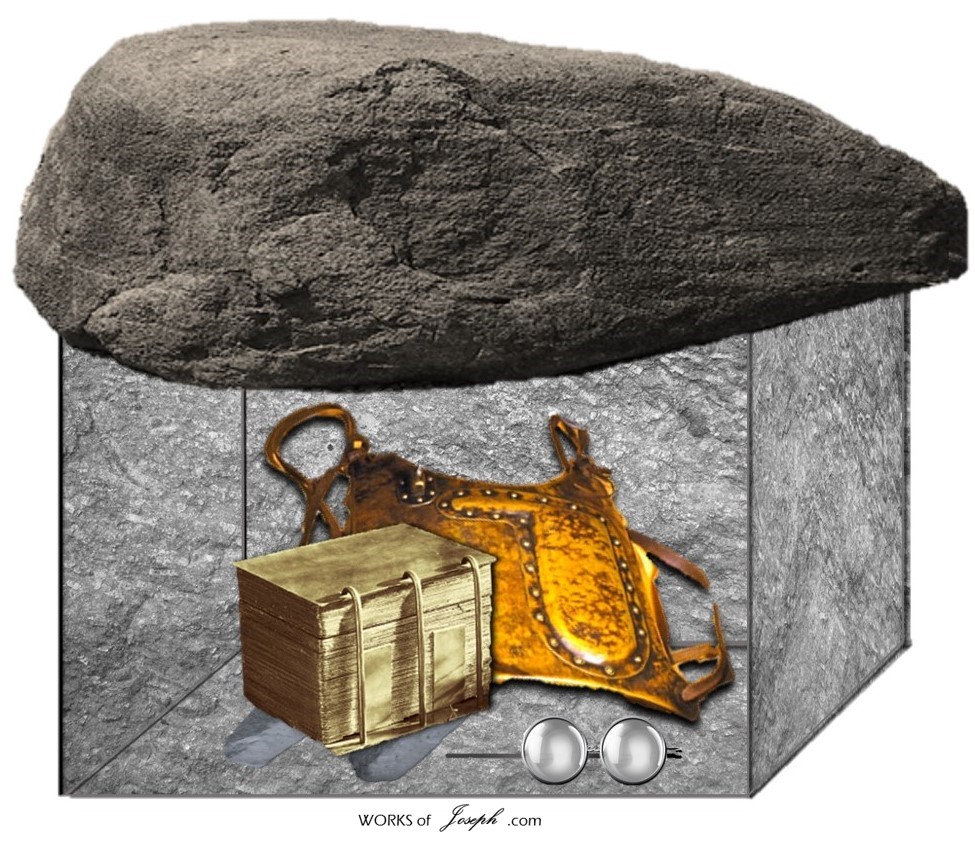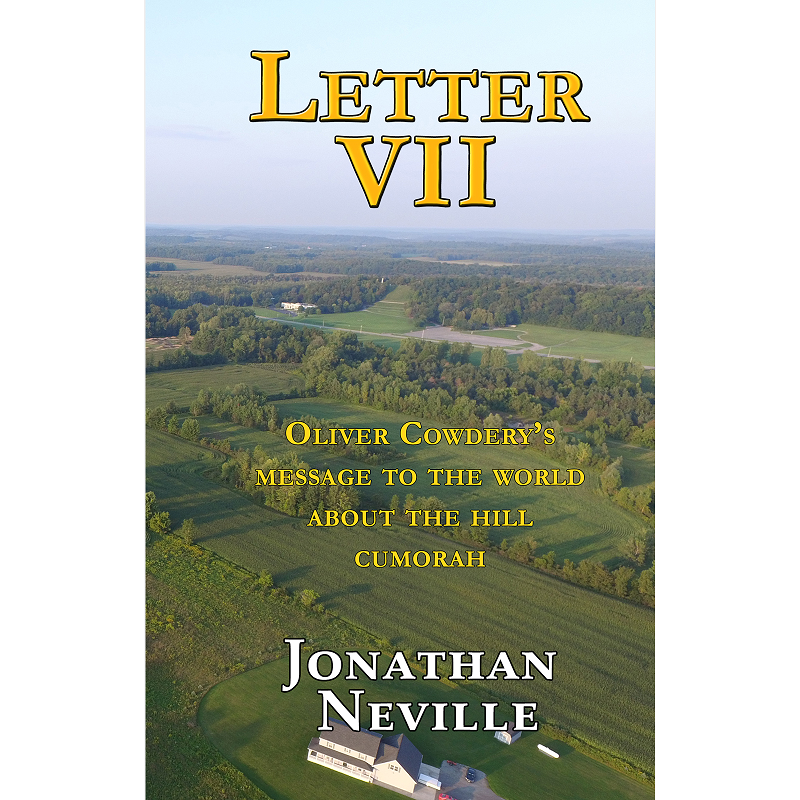
It has been almost 9 years since our friend Jonathan Neville first discovered at the Joseph Smith Papers online, and let the world know about these 8-Letters.
In my opinion the eight letters that Joseph asked Oliver to write about the History of the Church in 1835, should be read by everyone, and I feel they could even be scripture. (Oh, that is amazing, part of Letter 1 is scripture. Am I kidding? No! JSH 1:75n). Why haven’t you heard about them?
We know those historians of the Mesoamerican theory who believe in two Cumorah’s, don’t want anyone to know these letters exist. It would validate our Heartlander belief that there is only one Cumorah in NY and no where else. See Mesoamerican response of how Jonathan Neville is wrong here. I want to be fair, and let you read both sides of the issue and decide for yourself.
Joseph Smith had these letters copied into his personal journal. (That is how important they were to Joseph).They are online at the link below. Once at that link scroll down a few pages and the 8 Letters begin with the following words beginning with the bold title: Editorial Note
“The following section includes transcripts of eight letters Oliver Cowdery wrote in 1834 and 1835 regarding JS’s visions of an angel and his discovery of the gold plates of the Book of Mormon. Cowdery addressed the letters to William W. Phelps and published them as a series in the Latter Day Saints’ Messenger and Advocate between October 1834 and October 1835.” Joseph Smith Papers
Contents of Stone Box
There is also much confusion about what was contained in the stone box where Joseph received the plates from Moroni. Most members of the Church don’t understand there were two depositories at Hill Cumorah. In addition to the stone box where the gold plates were deposited, there was a separate cave at Hill Cumorah at a different spot than the stone box, that was about 15 feet deep by 15 feet wide, where wagon loads of plates were deposited, along with the Liahona, Sword of Laban, and other scrolls, papers. and artifacts. Read quote here: “The hill Cumorah, with the surrounding vicinity, is distinguished as the great battlefield on which, and near which, two powerful nations were concentrated with all their forces. Men, women and children fought till hundreds of thousands on both sides were hewn down, and left to molder upon the ground. . . . These new plates were given to Moroni to finish the history. And all the ancient plates, Mormon deposited in Cumorah, about three hundred and eighty-four years after Christ. When Moroni, about thirty-six years after, made the deposit of the book entrusted to him, he was, without doubt, inspired to select a department of the hill separate from the great depository of the numerous volumes hid up by his father. The particular place in the hill where Moroni secreted the book, was revealed, by the angel, to the prophet Joseph Smith, to whom the volume was delivered in September, A.D. 1827. But the grand repository of all the numerous records of the ancient nations of the western continent, was located in another department of the hill, and it’s contents under the charge of holy angels, until the day should come for them to be transferred to the sacred temple of Zion.” 1866 Orson Pratt Millennial Star (28 (27): 417)
Also at the end of this blog about the the letters and the stone box, I want your help in sharing your opinion on a question about the contents of “pillars” in the stone box, but how many pillars were there? By the way, was there found the Liahona or Sword in that box?
Did you know that Joseph had a seer stone or two while he was young? Almost everyone near Palmyra had a favorite stone or rock. We never hear in scripture that Joseph used his rock to translate the plates, however. What did Joseph use and what was contained in the stone box? You will learn some things you weren’t aware of, most likely.
Look who is coming to our Book of Mormon Conference in September.
Schedule of Speakers is here: Tickets Here
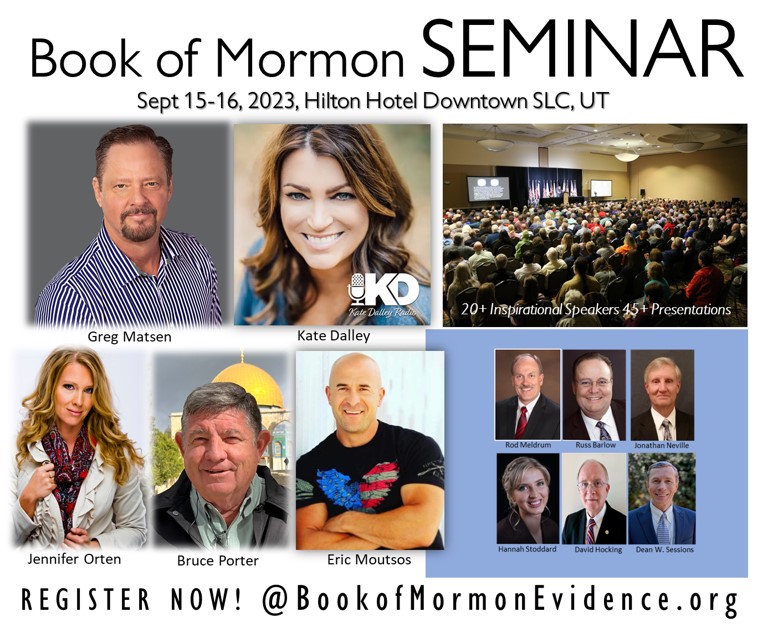 DID YOU KNOW?
DID YOU KNOW?
Of Oliver’s eight letters, portions of Letter I, are found in our scriptures and canonized? “See Joseph Smith – History after (See * after the number 75) verse 75.” The source reference is from Messenger and Advocate, vol. 1 (October 1834), pp. 14–16, which was originally published as Letter I. (This is an amazing fact that all members of the Church should know about. Ask yourself, why don’t you know this? Has it been hidden or not disclosed to us by some active member Historians and Intellectuals of the Church)? I believe the answer is possibly! Most of these Historians are wonderful people, but don’t want some of us to know any possible fallacies of them being wrong, about some history they want us to believe.
LETTER VII IS PUBLISHED IN THESE PUBLICATIONS: Messenger and Advocate (Kirtland 1835)
Messenger and Advocate (Kirtland 1835)
Copied into Joseph Smith’s Personal Journal (1835)
Quoted in Orson Pratt’s Pamphlet (1840)
Gospel Reflector (Philadelphia 1841)
Times and Seasons (Nauvoo 1841)
The Prophet (New York City 1844-45)
Liverpool Pamphlet (1844)
Millennial Star (1866)
Improvement Era (Salt Lake City 1899)
 “I think Letter VII was reprinted so many times because it was so important. Oliver’s history was the most complete history of the early days of the Church until the serialized History of Joseph Smith began running in the Times and Seasons in 1842, but it was also important for people to know that the New York hill was a touchstone for the Book of Mormon. It was a connection between ancient and modern times–a pin in the map.” Jonathan Neville
“I think Letter VII was reprinted so many times because it was so important. Oliver’s history was the most complete history of the early days of the Church until the serialized History of Joseph Smith began running in the Times and Seasons in 1842, but it was also important for people to know that the New York hill was a touchstone for the Book of Mormon. It was a connection between ancient and modern times–a pin in the map.” Jonathan Neville
J oseph Smith’s History, 1834-1836, contains Oliver’s letters, including Letter VII. You can find it in the Joseph Smith Papers starting with Chapter 1 on page 17. Oliver’s letters appear several pages later. Oliver Cowdery’s Letter VII as it appears in Joseph Smith’s own history “Letter VII,” LDS Messenger and Advocate, July 1835, 1:155–159 (Key to finding letter VII is to scroll down until you find the July 1835 article).
oseph Smith’s History, 1834-1836, contains Oliver’s letters, including Letter VII. You can find it in the Joseph Smith Papers starting with Chapter 1 on page 17. Oliver’s letters appear several pages later. Oliver Cowdery’s Letter VII as it appears in Joseph Smith’s own history “Letter VII,” LDS Messenger and Advocate, July 1835, 1:155–159 (Key to finding letter VII is to scroll down until you find the July 1835 article).
Letter I to Letter VIII Introduction
From the Joseph Smith Papers Project-
History, 1834–1836 Joseph Smith Papers.org
Editorial Note”
 The following section includes transcripts of eight letters Oliver Cowdery wrote in 1834 and 1835 regarding JS’s visions of an angel and his discovery of the gold plates of the Book of Mormon. Cowdery addressed the letters to William W. Phelps and published them as a series in the Latter Day Saints’ Messenger and Advocate between October 1834 and October 1835. The titles and formatting employed in this history are similar to those in the published series of articles, indicating that the Cowdery letters were copied into the history from the Messenger and Advocate, not from a manuscript version of the letters.
The following section includes transcripts of eight letters Oliver Cowdery wrote in 1834 and 1835 regarding JS’s visions of an angel and his discovery of the gold plates of the Book of Mormon. Cowdery addressed the letters to William W. Phelps and published them as a series in the Latter Day Saints’ Messenger and Advocate between October 1834 and October 1835. The titles and formatting employed in this history are similar to those in the published series of articles, indicating that the Cowdery letters were copied into the history from the Messenger and Advocate, not from a manuscript version of the letters.
Frederick G. Williams could have begun the transcription in JS’s history as early as 6 December 1834, the date of Cowdery’s last historical entry in the preceding section of the history. However, Cowdery probably gave the history to Williams around 2 October 1835, when he gave Williams JS’s journal. On 29 October 1835, JS retrieved the history from Williams and delivered it to Warren Parrish, who continued copying the Cowdery letters. It is likely that Parrish finished copying the letters by early April 1836, when he gave JS’s journal (and presumably the 1834–1836 history along with it) to Warren Cowdery
In the first letter [which part is canonized in our current scriptures], Oliver Cowdery recounted his experiences with JS beginning when the two first met in April 1829. The letter includes an account of the vision he and JS had of John the Baptist, who gave them the authority to baptize. After composing this letter, but before its publication, Cowdery developed a new history-writing plan: he decided that in subsequent letters he would relate the “full history of the rise of the church,” beginning with JS’s early life and visions. As editor of the Messenger and Advocate, Cowdery prefaced the published version of the first letter with an explanation (also transcribed into the history) of the new plan. Although he had no firsthand knowledge of church history prior to April 1829, Cowdery assured his readers that “our brother J. Smith Jr. has offered to assist us. Indeed, there are many items connected with the fore part of this subject that render his labor indispensable.” Some passages in the ensuing narrative seem to have been related to Cowdery by JS, since Cowdery recounts events in which only JS participated.
Cowdery composed the letters to inform the Latter-day Saints of the history of their church, but he also wrote for the non-Mormon public. Employing florid romantic language, frequent scriptural allusions, and much dramatic detail, he clearly intended to present a rhetorically impressive account of early Mormon history. He placed the rise of the church in a dispensational framework, characterizing the time between the end of the New Testament and JS’s early visions as a period of universal apostasy. He included the revivalism of various denominations during the Second Great Awakening, which JS experienced in his youth, as an example of the doctrinal confusion and social disharmony present in Christendom. Throughout the series of letters, he defended JS’s character and that of the Smith family, and his explicitly apologetic statements include apparent allusions to both Alexander Campbell’s Delusions (1832) and Eber Howe ’s Mormonism Unvailed (1834).
Beginning in the third letter, Cowdery provided the most extensive account of the origins of the Book of Mormon published up to that time. He related JS’s initial visions of the angel Moroni and, using biblical prophecies, elaborated on the angel’s message concerning the gathering of Israel in the last days in preparation for the Millennium. Cowdery continued his narrative up to, but did not include, JS’s receiving the gold plates in September 1827.
The transcription of the Oliver Cowdery letters into JS’s history was evidently conceived in terms of the entire series, not as a piecemeal copying of the individual letters. As noted above, Cowdery probably gave the “large journal” containing the history begun in 1834 to Williams in October 1835, the month of the Messenger and Advocate issue in which his final installment was published.
By the time Williams received the history, Cowdery may have already written the final letter; he had at least conceived of it as the final installment in his series. With the serialized Cowdery letters complete or nearing completion, the new history kept in the “large journal” could serve as a repository—more permanent than unbound newspapers—for a copied compilation of the entire series.

Letters from Messenger and Advocate The following communication was designed to have been published in the last No. of the star; but owing to a press of other matter it was laid over for this No. of the Messenger and ad[v]ocate. Since it was writen, upon further reflection, we have thought that a full history of the rise of the church of the Latter Day Saints, and the most interesting parts of its progress, to the present time, would be worthy the perusal of the Saints.— If circumstances admit, an article on this subject will appear on in each subsequent No. of the Messenger and advocate, until the time when the church was driven from Jackson Co. Mo. by a lawless banditti; & such other remarks as may be thought appropriate and interesting.
That our narrative may be correct, and particularly the introduction, it is proper to inform our patrons, that our brother J. Smith Jr. has offered to assist us. Indeed, there are many items connected with the fore part of this subject that render his labor indispensible. With his labor and with authentic documents now in our possession, we hope to render this a pleasing and agreeable narrative, well worth the examination and perusal of the Saints.
To do <Justice to> this subject will require time and space: we therefore ask the forbearance of our readears, assuring them that it shall be founded upon facts.
The Proper Method of Translation
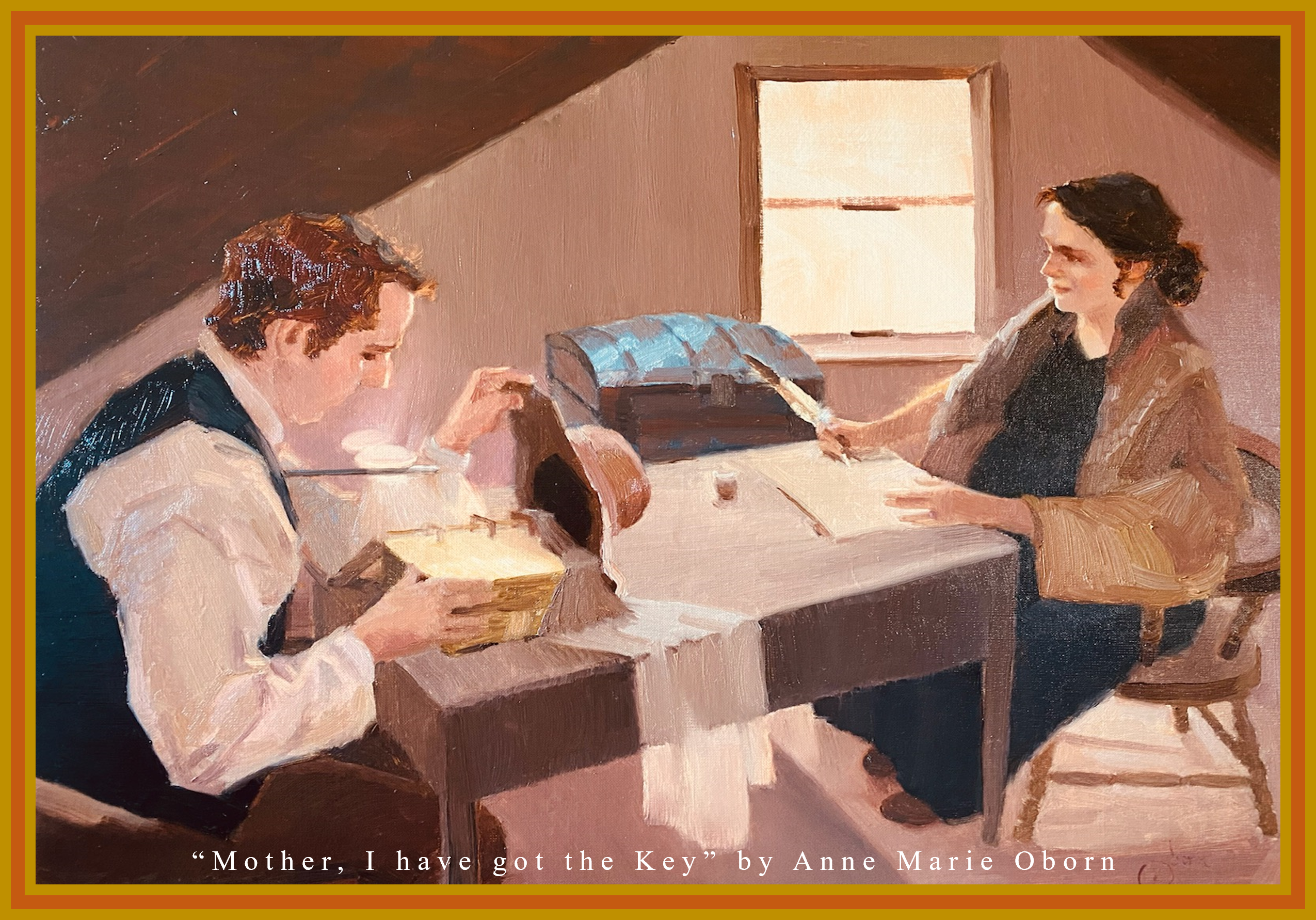
The Proper Method of Translation in my opinion is utilizing the three items that were contained in the stone box at Cumorah. There were only the gold plates, the breastplate, and the two stones in a silver bow similar to spectacles. With these three items the translation of the Book of Mormon came forth. No where in the scriptures do we hear of Joseph using a stone in a hat to translate. We also find credible sources that a curtain was not placed between Joseph and the scribe. For detailed explanation you can click below the artwork for additional information about scriptural verification and the words of Lucy Mack Smith.
HARD EVIDENCE SCRIPTURE REFERENCES https://www.bofm.blog/wp-content/uploads/2021/07/Book-of-Mormon-Hard-Evidence-Proper-Translation.pdf
26-PAGE “MOTHER I HAVE GOT THE KEY” https://www.bofm.blog/wp-content/uploads/2021/10/The-Key-Short-Version-a.pdf
4-PAGE SUMMARY https://bookofmormonevidence.org/bookstore/wp-content/uploads/2002/01/4-page-Proper-Translation-Using-The-Key.pdf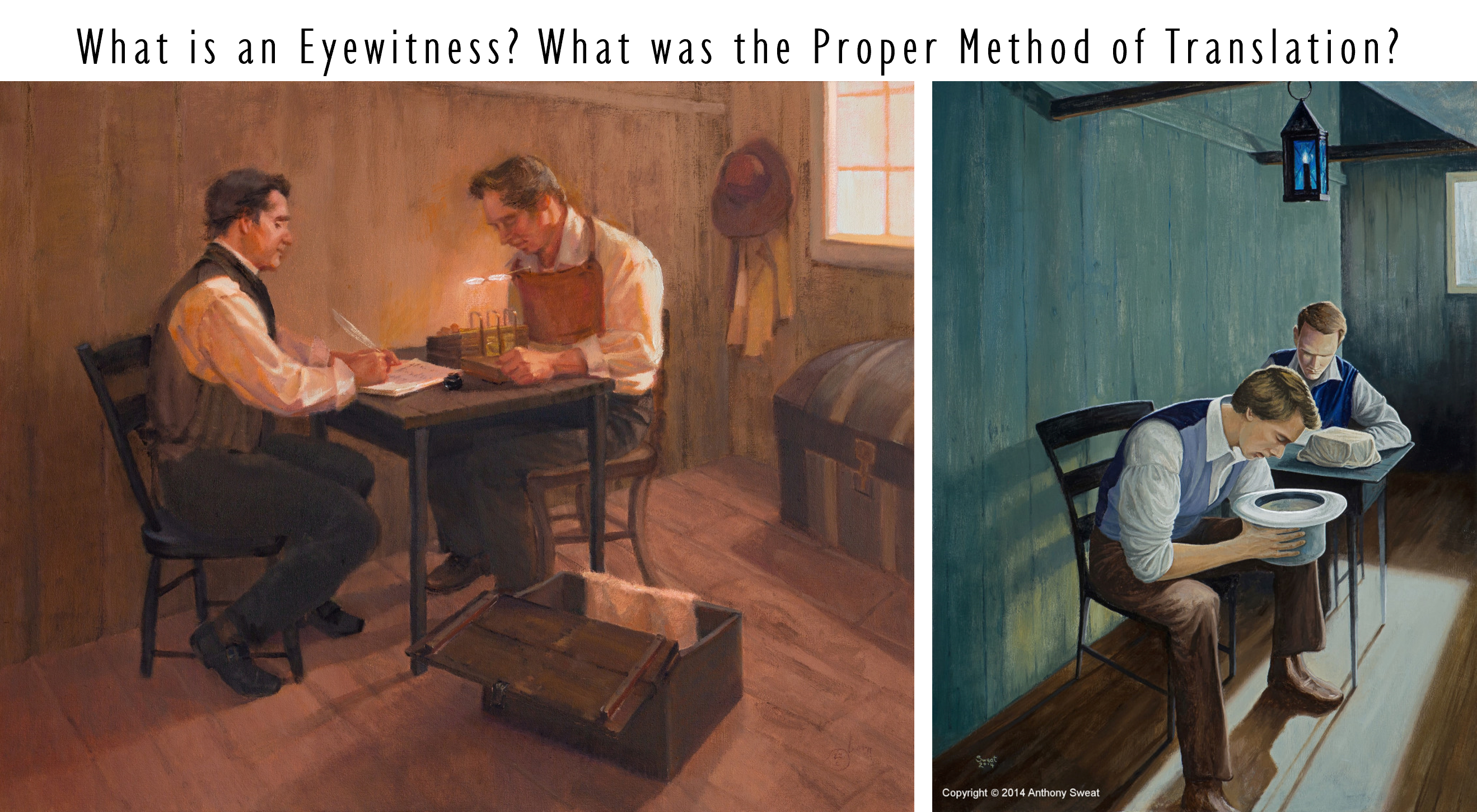
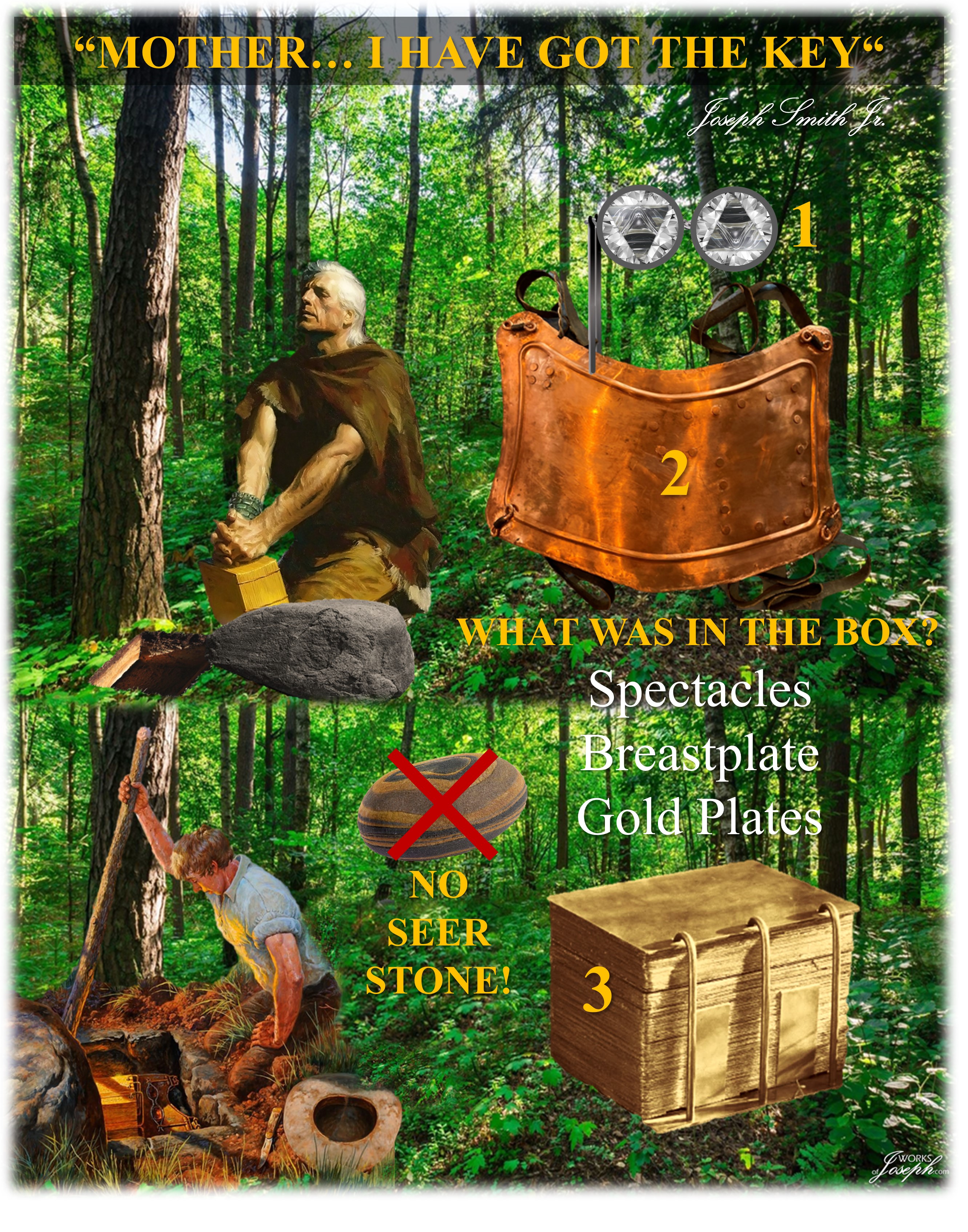
Did the spectacles really have the diamond shape in them? Lucy describes it here: “Examining it with no covering but a silk handkerchief, found that it consisted of two smooth three-cornered diamonds set in glass, and the glasses were set in silver bows connected with each other in much the same way that old-fashioned spectacles are made.” Lucy Mack Smith-Joseph Smith History
The Authentic Stone Box & The Cave at Cumorah

The items above are the only contents of the stone box where Joseph received the plates. There was not a single seer stone, there was not the Liahona, nor the Sword of Laban. There is no scripture that says this, many historians have made this up as you can see today in the Church History Museum, in the picture below.
Heartlanders say, “Mormon’s depository and Moroni’s stone box are in the same hill Cumorah in New York in different locations.” [One Hill Cumorah only in New York]
Mesoamericanists say, “Mormon’s depository is at some hill in Mexico, and Moroni’s stone box is in New York” [Neither one was necessarily called Cumorah. See “Saints” Vol. 1]
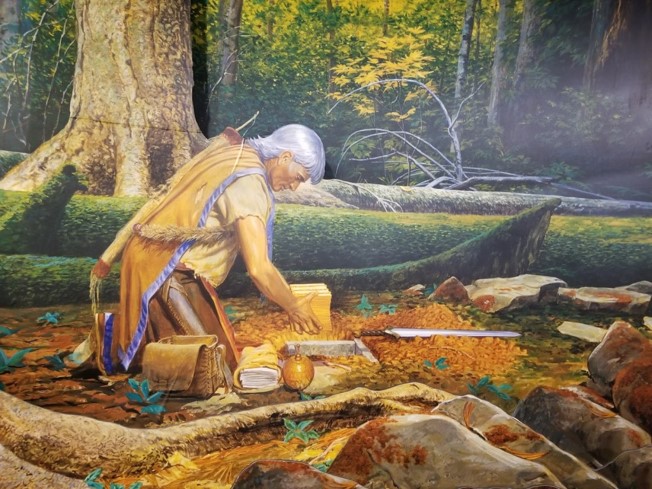
The Liahona and Sword were in the large cave at Hill Cumorah that Joseph entered with Oliver, where there were many many plates and records. Wilford Woodruff said, “[Joseph] went [into] a Cave in the Hill Comoro with Oliver Cowdry & deposited those plates upon a table or shelf. In that room were deposited a large amount of gold plates containing sacred records… Joseph Smith said that cave contained tons of choice treasures & records.” Wilford Woodruff Journal, 11 December 1869
Heber C. Kimball said, “Joseph and others… went into a cave in the hill Cumorah, and saw more records than ten men could carry… There were books piled up on tables, book upon book. Those records this people will yet have, if they accept of the Book of Mormon and observe its precepts, and keep the commandments.” Heber C. Kimball
Oliver Cowdery
“The manner in which the plates were deposited: First, a hole of sufficient depth, (how deep I know not) was dug. At the bottom of this was laid a stone of suitable size, the upper surface being smooth. At each edge was placed a large quantity of cement, and into this cement, at the four edges of this stone, were placed, erect, four others, their bottom edges resting in the cement at the outer edges of the first stone. The four last named, when placed erect, formed a box, the corners, or where the edges of the four came in contact, were also cemented so firmly that the moisture from without was prevented from entering. It is to be observed, also, that the inner surface of the four erect, or side stones was smoothe. This box was sufficiently large to admit a breast-plate, such as was used by the ancients to defend the chest, &c. from the arrows and weapons of their enemy. From the bottom of the box, or from the breast-plate, arose three small pillars composed of the same description of cement used on the edges; and upon these three pillars was placed the record of the children of Joseph, and of a people who left the tower far, far before the days of Joseph… I must not forget to say that this box, containing the record was covered with another stone, the bottom surface being flat and the upper, crowning. But those three pillars were not so lengthy as to cause the plates and the crowning stone to come in contact. I have now given you, according to my promise, the manner in which this record was deposited; though when it was first visited by our brother, in 1823, a part of the crowning stone was visible above the surface while the edges were concealed by the soil and grass, from which circumstances you will see, that however deep this box might have been placed by Moroni at first, the time had been sufficient to wear the earth so that it was easily discovered when once directed, and yet not enough to make a perceivable difference to the passer-by.” Oliver Cowdery, “Letter VIII,” October 1835


Joseph Smith Jr.
“Having removed the earth, I obtained a lever, which I got fixed under the edge of the stone, and with a little exertion raised it up. I looked in, and there indeed did I behold the plates, the Urim and Thummim [“Lights and Perfections” or allegorically, “Doctrine and Truth”; see pp. xix, 446, 560-61, 551], and the breastplate, as stated by the messenger. The box in which they lay was formed by laying stones together in some kind of cement. In the bottom of the box were laid two stones crossways of the box, and on these stones lay the plates and the other things with them.” JSH 1:52
Lucy Mack Smith
Lucy Mack Smith said, “[Moroni, after telling Joseph about the record, said] but you cannot get it until you learn to keep the commandments of God For it is not to get gain. But it is to bring forth that light and intelligence which has been long lost in the Earth
Now Joseph beware or when you go to get the plates your mind will be filled with darkness and all manner of evil will rush into your mind. To prevent you from keeping the commandments of God that you may not succeed in doing his work and you must tell your father of this for he will believe every word you say.
The record is on a side hill on the Hill of Cumorah 3 miles from this place. Remove the grass and moss and you will find a large flat stone pry that up and you will find the record under it laying on 4 pillars of cement— then the angel left him.” JSP Lucy Mack Smith, History, 1844–1845 https://www.josephsmithpapers.org/paper-summary/lucy-mack-smith-history-1844-1845/41
What Do You Think? Two? Three? or Four? Pillars?
I think it is most likely there were two stones on the bottom crossways of the box as this is canonized information. The Letter VIII information is a good secondary witness that there was something that the plates were sitting on top of such as the three pillars and of course Lucy Mack’s witness is always credible as she mentioned four pillars.

